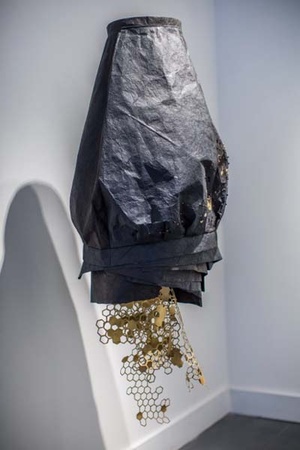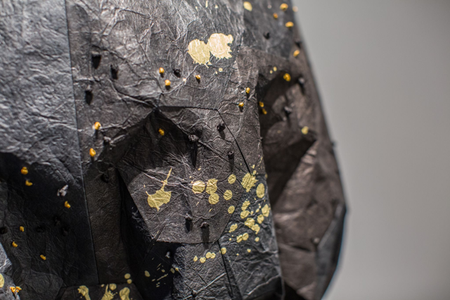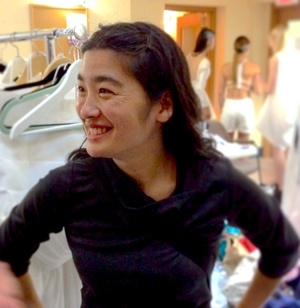“My craft practise connects me through lineage, to my ancestors. As I make, I think about how my maker hands connect me across the ocean divide beyond land and time.” —fashion designer Hitoko Okada
Growing up Nikkei in the cultural vacuum of a small rural community outside Toronto in the 1970s, one had to struggle for every scrap of positiveness that could be found in being of Japanese descent. This was well before anything “Japanese” was ever considered “cool”.
I find it significant now in middle age to reflect on the importance of my moves to BC, living on the site of Lemon Creek Internment camp, South Slocan, then to Japan where I learned with Japanese and gaijin friends who were on similar quests. Even the eventual return to Canada had its own epiphany.
Being Nikkei for me, then, is now a lot more than having family roots that go back to Japan (“So what?”, says the teenager), liking sushi, or having a penchant for things Japanese (Hello Kitty, anyone?).
The failure of the post-Redress Canadian narrative is that instead of evolving into something meaningful, the community truly lost its steam, direction, and significance and, ironically, any significant Nikkei voice. Those next generations that were born around Redress have now come of age but are no better off.
Besides hearing the voices of artists and writers then, there has been little serious exploration about what Nikkei means? Today, Nikkei, especially those with pre-WW2 immigrant roots, have a certain discomfort with dealing with things Japanese partly because they can’t speak Japanese, but mostly, I suspect, because they are uncomfortable with their Japanese selves which they have not really explored.
* * * * *
As I reread this interview, I am impressed by how grounded Hitoko is about who she is. Sure, being Shin Nisei places her closer to her Japanese roots than most of us, closer, too, to the culture that our grandparents and great grandparents physically left behind, but it is how she bridges the two solitudes, finding her own middle way, that is most intriguing to discover here.
First of all, can I please get some info about your age, education, where do you live, what do you do for work?
I am in my late 30s, living and working in Hamilton, Ontario. I moved to Ontario for education and work. After having lived in various towns across southern Ontario working in theatre costume departments, I settled in Hamilton.
I am a fibre artist, and as a clothier, I design and produce a line of handcrafted clothing under the label “HITOKOO” at https://www.hitokoo.com.
I studied at both Langara College in Vancouver, and fashion design at the International Academy of Design in Toronto.
Can you please tell me about your Japanese family? Your grandparents? Where did they live before coming to Canada? Why did they decide to come to Canada? What did they do for work, etc.?
My great-grandparents were kimono makers and cabinet makers in pre-industrialized Japan. My grandfather, Minoru Okada, was a self-taught machinist in post-war Japan. He didn’t have the opportunity to go to school, but through his hands he learned his craft, and supported his family.
When did your family arrive here in Canada?
My mother, Fumiko Okada, came to Canada in the seventies to live an alternative life to what was expected of her if she had stayed in Japan. Upon her arrival, she had worked as a bookkeeper, and waitress while going to night school to learn English and raising her small family. She is now preparing to retire this summer from WSIB Work Safe BC after over 25 years of service.
What did Canada offer your mother that Japan didn’t? Is she living in Vancouver now?
My mother chose to emigrate to Canada seeking independence and freedom away from the cultural expectations of a woman in her homeland. She was born near Tokyo, Japan but has lived in Vancouver for most of her life.
Are you Ijusha?
I am Canadian born.
What does being a “Shin-Nisei” mean to you then? Did it make it easier or more difficult to fit in?
I recently curated a group exhibition in Hamilton at both the Workers Arts Heritage Centre and Centre 3 gallery, titled -HOME (Hyphenated Home), which explored complex ideas of hyphenated identities from a selection of first generation Canadian artists across Canada including: Gu Xiong, Ingrid Mayrhofer, Amelia Jimenez, Damarys Sepulveda, and Farouk Kaspaules. I came into this project interested in the generational impact of the transnational experience.
I looked to these first generation artists that I worked with to inform these inquiries: If subsequent generations become increasingly disconnected to ancestral homeland, how do second or third generations negotiate their own sense of hyphenated identities? And how do Canadian born, non-indigenous, racialized minorities re-imagine ideas of home and belonging if they are perceived as “outsiders” within their country of origin? These questions are relevant to my experience as Shin-Nisei, and I think possibly to pre-war Nisei as well.
Very interesting… Through your discussions with these other new Canadians then, what are some of your common generational experiences? Is there anything particularly different about the Nikkei one?
Unlike first generation Canadians, I didn’t come from somewhere else to be here. I was born in Canada, and know of no other place to call homeland. Although I am not indigenous to Canada, I feel Canadian in my nationality. This wouldn’t be an internal conflict if not for the social experience of being an outsider in my country of origin because I am seen as Japanese here and nearly anywhere, except in Japan where I’m definitely not Japanese (defined by obvious things like the lack of language, but also more subtle cultural things like eating, walking, and how I engaged with others). Being an outsider in Japan was something that I could own because I was from somewhere else.
But in Canada, I had grown up being racialized and “other”-ed because I was socially identified as an outsider. And if I didn’t belong in my homeland, then I really didn’t belong anywhere.
From the -HOME (hyphenated home) exhibition, first generation Canadian artist Amelia Jimenez describes “home” in the liminal space between displacement and belonging as “a more fluid, elusive and uncertain place” constructed from ”memory or imagination.”
Furthering this notion, artist Gu Xiong explains that his artistic “practice centres on the creation of a hybrid identity arising from the integration of different cultural origins.” Through his work which “encompasses sociology, geography, economics, politics, and literature, as well as the dynamics of globalization, local culture, and identity politics, he constitutes an amalgamation of multiple cultural histories and seeks to create an entirely new identity. The construction of a new level of being.”
To navigate self between separateness and whole within a multi-layered context is how I have come to understand that my hyphenated experience and identity as nisei, is like a shadow or an echo I inherited from my mother’s journey between displacement and home.
Can you please talk a bit about your family both here and in Japan?

Photo credit George Qua-Enoo
I grew up in Vancouver, BC with my mother and sister. We were engaged in a Japanese Canadian community of newcomers that felt like an extended family. We got together for holiday and birthday parties, and all the kids played with each other. I believe my mother still meets with them once in awhile. They call these gatherings “Pandora-Kai” because I think their connections were made from living in an apartment complex on Pandora Street in East Van in their early settlement years.
As children, my sister, Sanny, and I flew to Japan during summer holidays and to spend time with our Japanese family living in Tokyo. My grandfather and uncle worked as self-taught machinists in their workshop on the ground level of their small house. All of us helped out in the workshop. I really enjoyed that.
Can you trace the evolution of your interest in your Nikkeiness? Did it start from a young age? Who most influenced this evolution?
As a youth I was very influenced by Tokyo street culture in Harajuku and Shibuya. It was the first time I saw clothes used as a medium for personal expression within a cultural context that I understood and that made a complete connection with me.
Although I did not dress in this style, I began to explore the idea of clothing and accessories as permission to express who I am, beyond the barriers of my race, and gender. This was my entry point into my relationship with clothing.
This trajectory evolved as I worked under a milliner and began to learn about fashion as it relates to society and history, and I continued on to work in theatre as a costumer to facilitate the creation of characters and story through wardrobe.
Is there a particular “Canadian” flavour to your style too then?
My work is a culmination of my influences, lived experiences, and an integration of what I’ve learned over the years in various capacities of design and craft work. But what may be my strongest Canadian influence is my connection to the west coast landscape where I grew up: the forests, the shoreline, and the ocean. I often use colours and textures that bring me back to this place in the world where I connect to a feeling of “home”.

© 2015 Norm Ibuki








